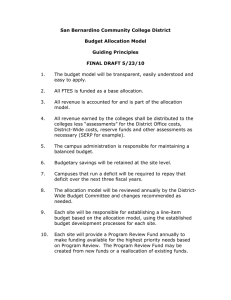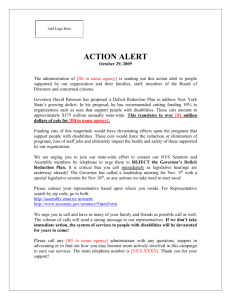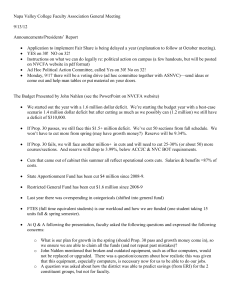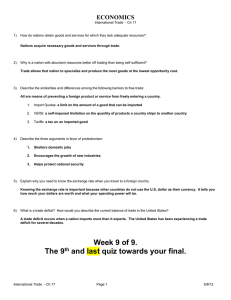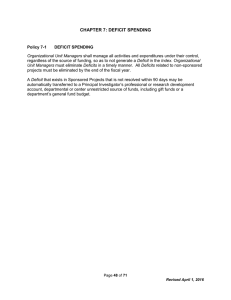Budget Update February 27, 2012 Kevin McElroy, Vice Chancellor, Business Services
advertisement
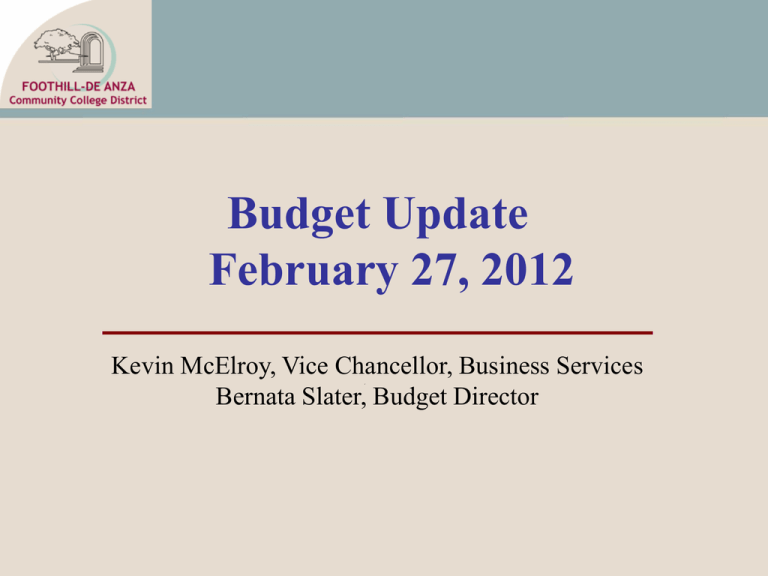
Budget Update February 27, 2012 Kevin McElroy, Vice Chancellor, Business Services Bernata Slater, Budget Director Current State Outlook for 2012/13 The state economy is improving, but… • there is still a structural deficit of $5.1 billion • in addition, the state is carrying a $4.1 billion deficit from 2011/12 (current fiscal year) • total projected deficit: $9.2 billion • absent policy changes, that deficit is projected to decrease to $1.9 billion by 2015/16 State Outlook, Continued The Governor’s Tax Plan To address the structural deficit, the governor has proposed: • A temporary increase in the sales tax and personal income tax rates on higher income earners (estimated revenue $6.9 billion). These tax increases would be included on the November 2012 general election ballot to be considered by voters • If voters do not approve the tax plan, the governor proposes $5.4 billion in automatic cuts The Community College System Budget If the tax package passes: • $218 million would be used to offset deferrals*. This would provide no new funds but would reduce borrowing costs and have a positive impact on interest revenue • $12.5 million would be used to establish a block grant to reduce the backlog of state reimbursable mandates to community colleges • would provide for additional adjustments for shortfall in student fee revenue and property tax shortfall * late payment of apportionment funds Categorical Flexibility • The governor proposes a massive overhaul of categorical programs • For community colleges, this proposal would take all categorical programs and place them in one block grant If Tax Initiative Fails – Mid-Year Cuts If voters do not approve the temporary tax increases, the community colleges’ budget would most likely change as follows: •$218 million in new money to fund deferrals would be canceled •$12.5 million in new money for the mandates block grant would be cut • Additional cuts would occur, and most likely would be implemented as an additional mandated enrollment reduction of approximately 5.56% Impact on Foothill-De Anza Best case scenario (tax initiative passes): • Status quo • no new funds • operating deficit carried (at least partially) from fiscal year 2011/12 • additional increase to operating expenses Worst case scenario (tax initiative fails): • Additional cuts of approximately $7.1 million, mitigated by a workload reduction of 5.56% • Sections/course offerings and part-time faculty hires would be reduced Additional Risk Factors 2011/12 Enrollment (Resident FTES) • Summer and fall enrollment indicates that we may be below our funded base, which would result in an additional estimated $2 million reduction to apportionment and a corresponding increase to our deficit Deficit Factor • In fiscal year 2011/12, property tax shortfall and student enrollment fee shortfall is estimated to reduce our revenue by approximately $4 million Discretionary Benefits • Our current deficit estimates do NOT include any estimates related to the discretionary benefits shortfall Additional Risk Factors, Continued The governor’s base revenue projections are more optimistic than those from the Legislative Analyst • However, if the Department of Finance’s projections are too high, funding proposed for the California community colleges may disappear as the budget process progresses Preliminary 2012/13 Projected Deficit Scenarios Revenue Expenses Net (Deficit) Additional potential reduction due to FTES loss Net deficit after adjustment for lost FTES Cuts to be implemented 6/30/12 Deficit as of 7/1/12 2012/13 Best Case Scenario – 2012/13 Worst Case Scenario – Status Quo Tax Initiative Fails Tax Initiative Passes 5.56% workload reduction imposed as an offset to $7.1M apportionment reduction 171,180,685 (182,473,144) (11,292,459) 163,518,154 (179,595,497) (16,077,343) (2,000,000) (2,000,000) (13,292,459) (18,077,343) 4,500,000 4,500,000 (8,792,459) (13,577,343) Preliminary 2012/13 Projected Deficit Scenarios, Continued These estimates will change and will be updated as more data is available Impact of Deficit on Foothill-De Anza • Currently, the colleges and Central Services are working on plans to close the 2011/12 fiscal year deficit, which includes additional ongoing reductions due to Tier 2 cuts • Under the worse case scenario, $7.1 million of additional cuts to apportionment would be accompanied by a mandated 5.56% enrollment reduction 2011/12 Cuts Allocation (before worse case scenario and before workload reduction) De Anza College Foothill College Central Services Target total $ 4,500,000 $ 3,100,000 $ 2,800,000 $10,400,000 Impact of Cuts on Colleges and Central Services • De Anza Report (Brian Murphy) • Foothill Report (Judy Miner) • Central Services Report (Kevin McElroy/Linda Thor) Available Resources to Help with Planning Stability Fund Colleges’ and Central Services’ Carryover •The Stability Fund plus the colleges’ and Central Services’ carryover is currently estimated at a total of $15-$17 million, contingent upon several factors such as 11/12 FTEF spend rate, available carryover balances, final FTES, etc. •Our 2012/13 estimated budget deficit of $13-$18 million will be reduced to $8.8 million (best case) to $13.5 million (worst case) after implementation of 6/30/2012 cuts of approximately $4.5 million. Our Stability Fund is currently estimated to be almost fully expended by no later than June 2013 at current expenditure levels. Next Steps The governor’s May budget revise is the next statutory step and, in the May revise, the governor will have the opportunity to evaluate: •Performance of current year revenue •Input re: his proposed budget •Variety of other factors •Other tax proposals Critical Dates • Governor will release his revised budget in mid-May • Tentative Budget will be presented to the Board June 18 • Both colleges and the district have committed to providing their worst case scenario budget plans to the Board no later than the end of June • Board of Trustees to adopt Foothill-De Anza’s 2012/13 Budget at the September Board of Trustees meeting with or without a final state budget Looking Ahead … • We will be serving approximately 32,000 to 33,700 (best case scenario) full-time equivalent students (FTES) • We will aggressively seek new revenue sources in support of critical programs and services
